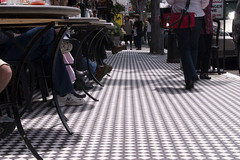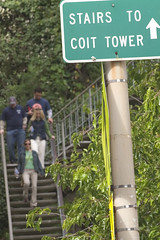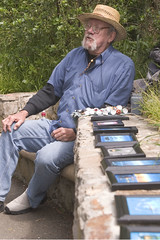Interview with a Photojournalist
Friday, May 27, 2005I found Chad Pilster through aphotoaday.org. Mr. Pilster graduated from SJSU in 2002 with a major in Photojournalism and a minor in Anthropology. While at San Jose State, Chad shot for the Spartan Daily, participated in the Eddie Adams workshop, and interned at the Metro Newspapers, the Grand Forks Herald, and the Hays Daily News. He is now a staff photojournalist at the Daytona Beach News-Journal in Daytona Beach, Florida.
How did you become interested in photojournalism?
In high school I wanted to get closer than a point and shoot would
let me at a pro baseball game. My dad had an old SLR that he gave me and I started learning how to use it and shooting sports with it. I got tired of sports and wanted to do something that would force me to get closer to people. I've been working with newspapers ever since.
How long have you worked in the field?
Three years. After I finished my second internship at a daily (The
first was at a weekly, the SVCN newspapers in the San Jose area. The first daily was the Grand Forks Herald, ND and the second was the Hays Daily News, KS) After graduating I moved to St. Louis.
How hard was it to break into the field?
Probably one of the hardest things I've done or seen done. I didn't
want to stay in the Bay Area or go to a weekly (Which might of made things a little bit easier), because it's so expensive to live and the traffic sucks. If you are going to get a job at a daily newspaper you have to be very good and very determined that this is what you want to do, or just lucky. I found out the other day that there are only 2500 newspaper photojournalism jobs in the U.S. and that number is going down. After graduating I applied to over 100 jobs and internships and only had a few bites. At one point you have high expectations of where you would like to end up and then you move those expectations to going to any newspaper.
I jumped in my car with my girlfriend (Who I had met on my last internship in Hays, KS and is now my wife) two weeks after graduation and started driving back to her house in KS. From there we went to the NPPA Convention in Minneapolis (The convention's are probably one of the best places to find jobs. I think it's called the BOP awards banquet now. A ton of bigwig photo editors from all over the country are there. Don't be bashful showing your portfolio around.) I didn't land a job, so we just randomly chose a place after talking to some people.
We headed off to St. Louis. I met with the Photo Editor at the Post-Dispatch, after dropping the name of someone who I had just met who previously freelanced for them, and showed my portfolio. They gave me enough work to live off of. Not until three months later, after I had stopped applying for new jobs, did I get a phone call from my current boss. Now I work at a 120k circ paper. I graduated with about eight people and I think all eight are still in the industry, but I thought they were all better shooters than me and only one of them is at a larger paper than me. In the three semesters that had graduates before me, with at least 12 people graduating, I think only a few people broke in the field.
Did digital technology change the way you work?
I started right on the verge of digital technology taking over. I was at internships where I would shoot film and the staff would shoot digital. They would loan me a digital if they were headed out of town or if we were on a tight deadline. I don't have a ton of experience with film outside of school. Even though it doesn't feel like it I think I shoot more now. When I shot film I shot a lot, but I have cameras with faster motor drives and I probably shoot even more now.
It's definitely much faster on the turn around. I can go back to the office much closer to deadline. If my paper would get me a wireless cell phone connection I wouldn't even have to go back to the office, but I haven't had a chance to experience much of that yet.
In reality we almost don't have to go into the office anymore. Although access to our assignments and the archives is only available at the office, because of a firewall.
Although we are able to get farther away from the paper more papers are pulling travel budgets and photographers are sticking closer to their newspapers more often. We almost never leave the county and use AP stuff for everything else. Even stuff within two hours driving distance we will use AP.
How has your work changed and/or developed over time?
At first most of my work was straight forward. I started making pictures, composing pictures with the basics in photography and just documenting what was in front of me. In college and over time I've learned of the elements that make the moment in pictures. After college I started looking at photographers who's work I would ask how they decided to make a picture or what were they thinking when they took a picture. Especially street photographers. I started trying to put that into my photography. I do a lot of layering now. Many of my images are about composition, light and the moments are a lot more subtle, but they are there. Sometimes I use the details in a photo to tell a story, but one image won't tell the whole story, instead it may make you ask the question "huh?" You won't always know the conclusion until you look at the package or a couple photos.
Which photographers influenced your style?
My current influences are Alex Webb, Nikos Economopolous, Robert Frank, Larry Towell, William Klein, Joachim Ladefoged. I love looking at the World Press Photo awards, they have some of the most cutting edge photojournalism and in my mind the best. I also like to watch independent/different films, they give you a different perspective on telling a story. Films like City of God, Punch Drunk Love, Mulholand Drive, Memento, 21 Grams, Amores Perros. I'm trying to do better with my portraits these days, so I've been looking at people like David Lachappelle. My influences change over time. I used to always look at the POY books so even though I don't look at them as much now I looked at them then, such as Rob Finch, Scott Strazzante, Brian Plonka, Kathy Plonka, Richard Koci Hernandez, Nachtwey, Salgado, Annie Liebowitz. Robert Capa and Weegee have also have an influence.
How have you balanced your professional and personal life?
My wife (and dog) comes first, but she what my job is about. My wife is currently in school and working about 60 hour weeks, so if I can get a chance to spend with her I will take it. She has Saturdays off and I work Saturdays, but I will usually be done by mid afternoon and we can do things at night. If the paper asked me to work on a day off, my first question is if I was going to spend it with her. If I am going to be doing nothing anyway, then I'd rather be out shooting. I haven't had any big projects that have tested my professional life against my personal life, but I believe that I have excellent communication with my wife and she would support whatever I was passionate about.
On another note, I carry a camera with me 90% of the time on or off the clock. I think the biggest thing that keeps me from shooting more personal stuff is finding time to organize and manage all of those images that I make. I have CDs and CDs of archived images, which I am sure I have good stuff and great memories on, but I can never seem to find the time to go through them. I try to save good personal and work images when I make them before they get lost in an archival abyss.
For more about Chad Pilster, please visit his website.












